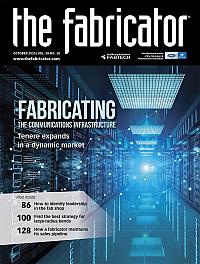Principal
- FMA
- The Fabricator
- FABTECH
- Canadian Metalworking
Categories
- Additive Manufacturing
- Aluminum Welding
- Arc Welding
- Assembly and Joining
- Automation and Robotics
- Bending and Forming
- Consumables
- Cutting and Weld Prep
- Electric Vehicles
- En Español
- Finishing
- Hydroforming
- Laser Cutting
- Laser Welding
- Machining
- Manufacturing Software
- Materials Handling
- Metals/Materials
- Oxyfuel Cutting
- Plasma Cutting
- Power Tools
- Punching and Other Holemaking
- Roll Forming
- Safety
- Sawing
- Shearing
- Shop Management
- Testing and Measuring
- Tube and Pipe Fabrication
- Tube and Pipe Production
- Waterjet Cutting
Industry Directory
Webcasts
Podcasts
FAB 40
Advertise
Subscribe
Account Login
Search
Lean manufacturing needs leaders
How to grow lean leaders throughout manufacturing organizations
- By Jeff Sipes
- November 20, 2020
- Article
- Shop Management

Lean manufacturing needs lean leaders. Now is the time for metal fabricators and other manufacturers to take inventory to see who has what it takes to to spearhead those operations. Getty Images
Here’s a challenge for you. Take an inventory of the lean leaders in your company. Look for those who behave consistently from day to day in a lean way. Do they understand flow? Are they fanatics about waste elimination? Do they use data to make decisions? Do they know about lean methods and techniques? Most important, do they respect people, and are they capable and willing to lead others?
If you assess your lean leaders honestly and objectively, you might be surprised at what you find. You might have a deeper bench of lean leaders than you expected, or you might find that the bench is weak or nonexistent. For those in the latter category, how do you grow lean leaders to enable your company to achieve its potential?
Where Are the Lean Leaders?
Lean leaders could be anywhere in the organization, from the top floor to the shop floor. They’re in the executive suite, in the management ranks, and in the hourly workforce. They are in production, engineering, sales, purchasing, and elsewhere. Lean leaders aren’t likely to be in all of these places at a single company, but they could be.
The point is you can find lean leaders being effective and adding value anywhere in the organization. Their job titles don’t constrain them. They demonstrate lean leadership in the way they conduct themselves, and people around them recognize them as lean leaders.
Lean leaders are not cookie-cutter, one-size-fits-all sorts of people. One lean leader who’s vice president of operations and another who’s a robotic weld cell operator might have a common basic understanding of lean manufacturing and share a passion for improvement, but they have different levels of influence and perspective. The senior person spends her time with lean strategy matters, while the welder spends his time with lean tactics. That’s OK, because both are vitally important to the successful lean journey.
Senior Management. Lean leaders in senior management set direction to connect the lean strategy to the business strategy. If well done, the lean strategy will enable the business strategy to be executed. Senior managers control the purse strings, so they must be well-versed in lean investments and resource deployment. Since they have great influence on the behavior and culture of the organization, they must be visible and lead by example.
Middle Management. Here lean leaders develop the lean direction and strategy. They think about end-to-end processes and aggressively work to bust the functional silos. They straddle between the strategic and tactical approaches to making the lean journey happen. They also identify and cultivate tactical lean leaders. They need to make tough calls, but by leading by example, they get it done.
Supervisor. At this level, lean leaders strike an appropriate balance between working in the system (getting the product out the door) and working on the system (spending time every day developing people and improving the way work is done). They develop and encourage front-line personnel and organize, lead, and support formal and informal improvement projects. They spend most of their time in gemba (where the work takes place and value is created) and have earned the respect of people throughout the organization.
Front-line Employee. At this level, lean leaders most likely are informal leaders who take initiative. They participate actively in improvement projects (kaizen events) and improvement efforts (everyday kaizen). The front-line lean leader knows the real current state and is therefore in a position to identify ways to make the jobs better.
Lean Manager. This is the company’s “lean person” who has a job title like lean manager, lean specialist, or lean sensei. This manager’s fulltime job is to promote, advance, and enable the organization to become a high-performing manufacturing business. A catalyst, this high-energy person is affable and thick-skinned, has deep knowledge of the business, and has an insatiable desire to learn. The lean specialist is persistent, thrives in front of groups, and will not take no for an answer.
How Do You Grow Lean Leaders?
Say you find that your bench of lean leaders is weak or nonexistent. Now what? You might kick-start the lean leader bench-building with a select hire or two. Hiring from the outside might allow you to bring deep skill to the organization quickly, but it’s really not an effective long-term strategy. So how do you grow lean leaders internally so that you promote internal advancement and protect your company culture?
Consider the following lean leader development road map. Although these steps could be modified to suit your situation, they at least can help get your lean-leader development started.
Step 1: Identify Executive Support. Developing lean leaders should be part of your operational strategy and therefore needs executive horsepower. Identify who among the senior management has the interest, willingness to learn, and passion for improvement to be the senior face for your lean journey. Your lean journey is at risk without senior leadership.
Step 2: Identify the “Lean Person.” This person will drive deployment, assist in strategy development and tactical execution, and have multiple balls in the air at all times. Consider this an “A” player who can influence all levels of your organization. If this person already has lean experience, great. Turn him loose. If he doesn’t but has the potential to be effective, then send him to training workshops, have him join a professional organization, and perhaps hire a mentor to help get him up to speed quickly. This truly is an investment, and you should expect results.
The lean sensei is a glue that holds all the pieces of the lean journey together. She is the teacher, coordinator, and conscience who gets the resources to the right place and makes decisions at the right time, either through influencing or directing. Remember, the lean sensei does not take no for an answer.
Step 3: Identify Managers and Supervisors for Lean Leadership. Ideally, all managers and supervisors demonstrate some level of lean-leader capability, but in the beginning you need to handpick a few of these people to lay an operational foundation. With the support of the lean leaders at the executive level and the lean sensei, these few managers and supervisors will be empowered to learn and do. Use outside resources if necessary to accelerate their learning and the lean sensei to accelerate their doing (hands-on application of lean methods and techniques).
Step 4: Educate and Train the Core Lean-leader Team. Provide continual, frequent, and aggressive training for this core group. The sooner they are up to speed, the sooner they will be able to influence successful outcomes. You may decide to have everyone in the core group understand the basics and then develop more specialized depth in certain topics for subsets of the core group. Everyone does not need to be a specialist in everything.
Step 5: Educate the Workforce and See Informal Leaders Rise to the Occasion. Now educate the whole workforce about the basics of lean concepts, reasons that the company is investing in lean, and how lean practices and behaviors may result in change. Then provide specific training in relevant lean methods and tools for each project team. If the team is not working on changeover, then don’t train them in quick changeover. If a team is working on setting up a production cell, then train deep on cellular arrangement. You will see informal leaders from the front line begin to emerge. Support them, empower them, and give them opportunity to be more involved. These will be your front-line lean leaders.
Now it’s time to execute and support the effort. Notice that these steps to develop lean leaders represent a cascade approach designed to sustain the top-management support so critical for long-term success. The same goes for your lean-leader managers and supervisors. They have to support the front-line activities through process improvement and personnel growth.
Lean Needs Leadership
When you get all your lean leaders in place, hang on for a wonderful experience as your company achieves higher levels of performance. The ride will get rough sometimes, but that’s when your lean leaders become the stabilizing force to keep everyone focused.
Without a deep bench of lean leaders in the right places in your organization, your lean journey is less likely to succeed. If your bench is deep, wonderful. But be honest with yourself when you make that assessment. If the bench is weak, you have work to do.
About the Author

Jeff Sipes
9250 Eagle Meadow Dr.
Indianapolis, IN 46234
(317) 439-7960
subscribe now

The Fabricator is North America's leading magazine for the metal forming and fabricating industry. The magazine delivers the news, technical articles, and case histories that enable fabricators to do their jobs more efficiently. The Fabricator has served the industry since 1970.
start your free subscription- Stay connected from anywhere

Easily access valuable industry resources now with full access to the digital edition of The Fabricator.

Easily access valuable industry resources now with full access to the digital edition of The Welder.

Easily access valuable industry resources now with full access to the digital edition of The Tube and Pipe Journal.
- Podcasting
- Podcast:
- The Fabricator Podcast
- Published:
- 05/07/2024
- Running Time:
- 67:38
Patrick Brunken, VP of Addison Machine Engineering, joins The Fabricator Podcast to talk about the tube and pipe...
- Trending Articles
White House considers China tariff increases on materials

A deep dive into a bleeding-edge automation strategy in metal fabrication

A visit to Automate 2024 reveals the future might be now

Majestic Steel Arkansas fully operational

Rivian to expand Illinois facility to manufacture midsized SUV

- Industry Events
Laser Welding Certificate Course
- May 7 - August 6, 2024
- Farmington Hills, IL
World-Class Roll Forming Workshop
- June 5 - 6, 2024
- Louisville, KY
Advanced Laser Application Workshop
- June 25 - 27, 2024
- Novi, MI
Precision Press Brake Certificate Course
- July 31 - August 1, 2024
- Elgin,


























